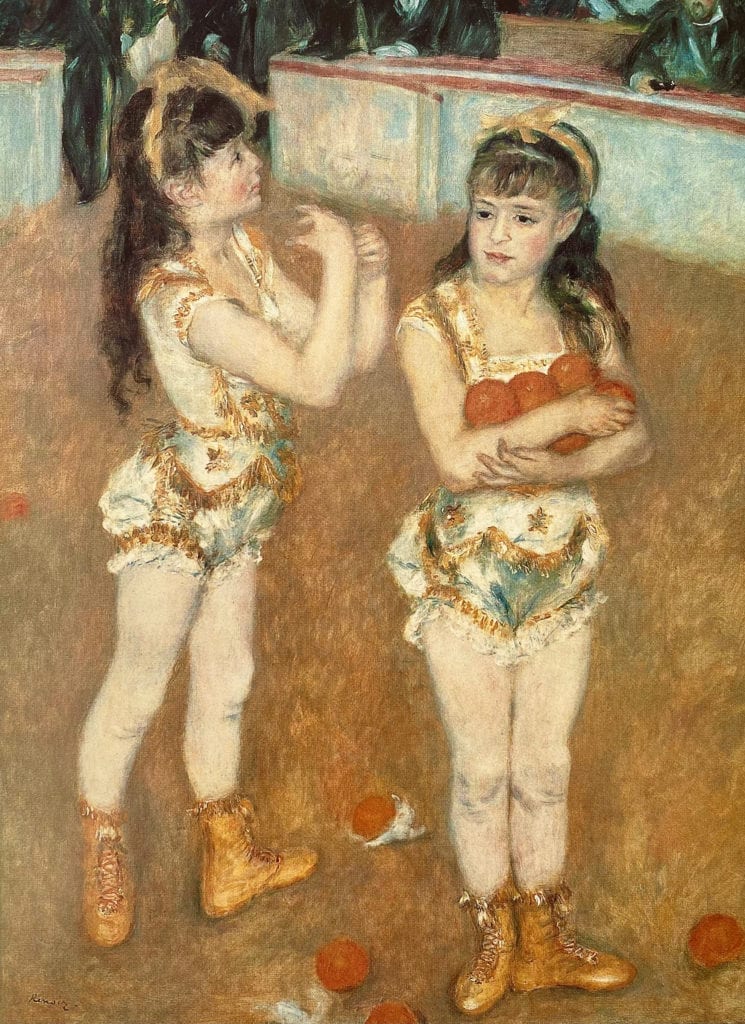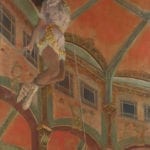What’s the story with Renoir’s Acrobats at the Cirque Fernando?
- Truth about his real acrobat models
- What oranges represent
- Darkness lurking nearby
Click below for the podcast version of this piece.
Renoir’s idealistic sweetness balances with bitter bits in Acrobats at the Cirque Fernando. The painting celebrates youth and beauty. It glows with Renoir’s characteristic soft touch. He’s the king of blurred edges and blushing cheeks. Collectors favored his paintings and this one’s no exception. Its owner, Mrs. Potter Palmer traveled the world with it by her side. She loved it so much – “Cissie” never let it go. This isn’t surprising given its magic. There’s also intrigue in the piece’s underlying darkness. This masterpiece dances between appearance and reality.
On the surface, Acrobats at the Cirque Fernando evokes childlike wonder. The younger girl, Angelina, clutches an armful of oranges. An audience gift after the duo’s performance, they shield her chest. The way she holds the fruit close seems protective. Her sister, Francisca, also gestures toward herself rather than the spectators. Both girls hold their arms inward. It’s customary to acknowledge your audience and gesture outward, toward them. These arm positions signal that our young acrobats feel threatened. They also wear few clothes for 1879. This exposes their bodies more than would be the norm in those days. Angelina and Francisca Wartenberg pose like tiny, dainty preteens. But they’re clad as much older women.
Acrobats at the Cirque Fernando portrays a fantasy. In fact, these girls were 14 and 17 years old. Renoir depicts them much younger. That may be why he covers both of their chest areas. Girls often have developed breasts by their teen years. But the French painter portrays them as much more childlike here. He composes this as a portrait of innocence. It doesn’t matter that in reality these girls were not this delicate. There are photographs of the actual sisters. As athletes, they have strong, muscular bodies. Their feet are not positioned in delicate ballet poses like these. Acrobats at the Cirque Fernando shows a perfect example for Renoir’s gentle touch. With this artwork, he gives the sisters back their innocence. But there’s a price.

Darkness in the Details
My favorite detail from Acrobats at the Cirque Fernando is so subtle, you may not see it. There’s an orange between the Wartenberg sisters. A white paper wrapper still clings to it. But the fruit is almost freed from this former enclosure. It’s escaping. But for these girls, there’s no escape. Oranges symbolize fertility. They’re a robust, feminine fruit – packed with potential. The sisters too represent possibility. They will grow and change into strong and talented women. That future emanates through this painting. It’s a dark and subtle underlayer.
French painter, Renoir didn’t do this often. His work celebrates feminine beauty. It delights with soft edges and sensuality. Renoir helped found Impressionism. He even presented the first Impressionist exhibition with his buddies, Monet and Pissarro. That was five years before this painting – in 1874. After a rocky start, he gained acclaim. In part that may be thanks to paintings like Acrobats at the Cirque Fernando. That’s because even with its gentle and frilly sisters, there’s a meaningful undertone.
Faceless men in dark suits surround the sisters. They lurk in the audience. The male figures seem threatening because all we see are their large hands and black clothes. Viewers also notice the sisters’ fearful expressions. Angelina looks away from them, cradling the oranges in a self-comforting gesture. While Francisca holds her arms up as if to shield herself from the audience. When Renoir made them younger than their actual ages, he returned them to childhood. Like a time machine – he halted their adolescence. In the world of Acrobats at the Cirque Fernando they’re little girls forever. Adulthood must wait in the peanut gallery for the moment.
Acrobats at the Cirque Fernando – FAQs
Where can I see Acrobats at the Cirque Fernando in person?
The Art Institute of Chicago mounted the masterpiece Acrobats at the Cirque Fernando among their 25 Renoir pieces. This exhibit highlights the wonders of museum technology. Elements of the paintings are x-rayed and illuminated. Infrared light and technical imaging show us even more than a mere x-ray. These techniques reveal layering and even drawing beneath the final works. It gives viewers an alternate way to see familiar artwork.
Why did Renoir paint Acrobats at the Cirque Fernando?

Although we can’t know the contents of the master’s mind, some facts hint at his reasons. Renoir was part of an artist collective. His peer group were some of the finest master painters of the time. Many of them loved to paint scenes at the Cirque Fernando. For instance, Degas painted Miss La La at the Cirque Fernando. He created it the same year Renoir painted Acrobats at the Cirque Fernando.
The Fernando was a popular location on the Boulevard de Rochechouart, between the rue des Martyrs and the present rue Viollet-le-Duc. This sits quite close to Montmartre, the area where many artists lived during the Belle Époque. It’s an impressive list including Renoir, Degas, Pissarro, Monet, Toulouse Lautrec, Picasso, and Van Gogh. Several of these masters painted the nearby Cirque Fernando at least once.
Why is Pierre-Auguste Renoir an important painter?
There are many ways Renoir impacted Art History. He helped start the Impressionist movement in Belle Époque, Paris. This was the time right before WWI when all seemed merry and bright. So, Impressionism’s soft, gentle musings suited the period. Renoir also made profound and sensual portrayals of women. Many Art Historians point to his late nudes as Renoir’s greatest achievements. He was also prolific, painting thousands of pieces. His work remains quite popular. In fact, it’s a tight contest between his productivity and fandom. One thing we know for certain, many of his paintings are beloved masterpieces.
Enjoyed this Acrobats at the Cirque Fernando analysis?
Check out these other essays on French painters.
Ishbel Ross,Silhouette of Diamonds: The Life of Mrs. Potter Palmer,1984
Jean Leymarie et Michel Melot (1971). Les Gravures Des Impressionistes, Manet, Pissarro, Renoir, Cezanne, Sisley. Paris: Arts et Metiers Graphiques
Art Institute of Chicago page for Acrobats at the Cirque Fernando
Adrian, Histoire illustrée des Cirques parisiens d’hier et d’aujourd’hui (Bourg-la-reine, Adrian publisher, 1957)
Cirque Fernando today
